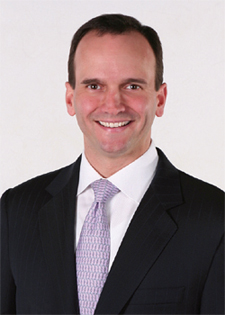A Conversation with P. Harris Morris

P. Harris Morris
P. Harris Morris, previously vice president and general manager of the Media and Workflow area of the Harris Corp.'s Broadcast Communications business, was recently appointed president of the sector. He offered his observations on today's industry to TV Technology just prior to NAB.
LAS VEGAS
TV TECHNOLOGY: The past few years have seen challenges for the traditional broadcast business at Harris, as we see reflected in the company's financial results. Describe the outlook now for broadcast.
MORRIS: We still see play-to-air solutions as a significant leg of our global growth. The other pieces are channel creation and play-out; production, especially for sports, news and live content, [as are] distribution, including multi-system operators and satellite.
TV TECHNOLOGY: What adjective would you use to describe the relevance of traditional broadcast within your business, compared to non-radio/TV?
MORRIS: Vital. It's the lion's share of our business.
TV TECHNOLOGY: Harris opened its Mason (Ohio) Broadcast Center to much attention several years ago, but it has since scaled back the size and scope of the manufacturing staff. Is the Mason facility outsized for the broadcast business now?
MORRIS: The short answer is that we have three hubs to our business: Denver, Toronto and Mason. There are many more service and sales sites worldwide. Mason will continue to be an important location for Harris Broadcast, in particular for our transmission products and our play-to-air solutions that are helping to drive global growth.
The transmitter is part of an entire workflow that includes encoders, exciters and channel play-out systems. Our goal is to supply interoperable solutions for specific segments of the TV business; these play-to-air solutions are a critical piece [of that approach].
TV TECHNOLOGY: What will Harris feature at NAB this year?
MORRIS: First, we'll unveil dozens of new point products; [Harris will also] display and deliver end-to-end workflows for news and sports production, channel creation and play-out. Those workflows benefit our core customers as well as take us into adjacent markets, such as sports venues, digital signage and out-of-home advertising, plus government situational awareness.
TV TECHNOLOGY: What are the most effective parts of your skill set and how does it benefit Harris Corp.?
MORRIS: Team building and visionary leadership. We have a global business that serves customers in all parts of media in almost every country, so I'm cultivating a strong global team.
In terms of visionary leadership, the media industry is undergoing a great deal of change. That's exciting, as well as daunting, so our customers increasingly rely on us to help them learn about what is working for media companies worldwide.
TV TECHNOLOGY: How is Harris using online services to reach out to its customers?
MORRIS: Last year at IBC, we introduced a virtual world where customers could explore Harris solutions and engage with our technologists. The next piece is product support, from product configurators to research and service offerings. This year we'll roll out a new e-commerce platform to allow our customers to research products, place orders and check status, as well as find service bulletins, manuals and other service support.
TV TECHNOLOGY: How about the Interoperability Lab for TV that was opened two years ago in Toronto? How is that operating? Has it been reduced, enlarged, etc.?
MORRIS: To say it's been enlarged would be an understatement. We are running dozens of interoperability initiatives and have built out labs in Denver; Northridge, Calif.; and Winnersh, England. They're connected, which allows us to mimic real world workflows and deliver solutions.
TV TECHNOLOGY: TV broadcasters face several threats to their business, from increasing competition to online and other video services to the threat of losing spectrum under the FCC's broadband initiatives. How should the broadcast industry respond to the spectrum issue?
MORRIS: We believe that the broadcast model is a proven way to use spectrum to reach mass audiences efficiently and cost-effectively. We're seeing countless innovations by TV stations that allow them to utilize this high-value spectrum, from multicasting of HD and SD programming to the delivery of live television to mobile devices.
For example, Harris worked with the OMVC and LG to develop the ATSC Mobile DTV standard. Now, we're working with Capitol Broadcasting/WRAL-DT in Raleigh, N.C., to deploy a public transportation solution that combines mobile handheld and digital out-of-home solutions to create an entirely new entertainment, information and advertising network.
TV TECHNOLOGY: Are you satisfied with the rollout of Mobile DTV? What are your hopes for the service during the next 12 months?
MORRIS: We are extremely satisfied. The progress that the industry has made is nothing short of stunning. Broadcasters have shown the initiative and spirit to create a new business model. Harris, in cooperation with LG, is committed to invest in enabling this market, which is paying off for us and our customers.
We have delivered more than 45 systems nationwide already and, at the upcoming Washington, D.C., Mobile Consumer Showcase, our systems will be used in at least six of the eight over-the-air broadcast stations.
Also, we're aligned with other tech companies, like Roundbox and iSet, to develop and market mobile apps that will help broadcasters monetize the mobile service model. We wouldn't be surprised to see 100 to 150 more stations roll out mobile capabilities during the next year.
Get the TV Tech Newsletter
The professional video industry's #1 source for news, trends and product and tech information. Sign up below.
Mark R. Smith has covered the media industry for a variety of industry publications, with his articles for TV Technology often focusing on sports. He’s written numerous stories about all of the major U.S. sports leagues.
Based in the Baltimore-Washington area, the byline of Smith, who has also served as the long-time editor-in-chief for The Business Monthly, Columbia, Md., initially appeared in TV Technology and in another Futurenet publication, Mix, in the late ’90s. His work has also appeared in numerous other publications.

